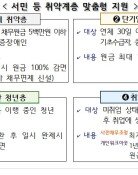Family Volunteering Serves Multiple Purposes
Family Volunteering Serves Multiple Purposes
Posted December. 05, 2007 08:26,

At a restaurant in Gwacheon, Gyeonggi Province, on the morning of December 2, lunch boxes were piled up waiting to be delivered to the disabled and the elderly living alone. Four families comprising about 20 people gathered together for the task.
Park Ik-sun (43) lined up with his wife Choi Jong-mi (41), his son Jeong-hyeok (14), and his daughter Do-yun (12). The Park familys objective was to visit seven places to deliver 13 lunch boxes. As the delivery had to be done before lunchtime, they set out without delay.
While visiting the elderly, they not only delivered the lunch boxes but also exchanged greetings and become companions to whom the elderly could chat. Normally, it takes about 2-3 hours for them to finish their delivery.
The first visit was to Kim (age 77)s house. Choi asked, Are you eating well and not skipping your meals? Kim answered, I drank a lot yesterday. I wanted to have warm soup. Thank you.
Jeong-hyeok said, I like doing the lunch box delivery with my family. While volunteering, Ive come to realize that there are many who are less fortunate than us.
It has been three years since the Park family began volunteering. Last year, they cleaned a nursing home, and this year they started the lunch box delivery.
Volunteering in Korea has several decades of history, yet family volunteering did not start in earnest until 2000. Last year, the Health Family Support Center under the Ministry of Gender Equality and Family oversaw 29 family volunteering programs nationwide. This year the number has increased to 50.
Yoo Hee-jeong, a social worker from the Volunteer Center in Gangnam-gu, Seoul, said, At the beginning of 2000, there were almost no applicants for family volunteering. These days it has become so popular that we now have a waiting list.
My Kids Have Become Considerate...-
A family must move together while volunteering, thereby creating more chances for family members who do not find enough time to talk to each other to become closer. It is also a good opportunity for parents to have their children personally understand the nature of volunteering.
Park, an interior businessman, said, I go to work early in the morning and come back late. It was difficult to see my children at home before we started volunteering. Family volunteering has afforded me more time to talk to them.
Kim Hyeon-ok, a representative of the Seoul Volunteering Center, commented, Just like other activities, volunteering is like a habit. That is, if you experienced volunteering as a child, when you become an adult, you are more likely to actively participate in it.
Kim Ae-ja (46 years old, Daechi-dong, Gangnam-gu, Seoul)s family has been volunteering to assist the disabled for two years. My kids were not sociable before. They have now become very active and are proactive in helping the disabled when they see them. My husband used to be rather hardheaded, but now he is the one who pays great attention to following the volunteering date.
Visiting Elderly is Most Frequently Done by Family Volunteers-
Family volunteering ranges from visiting the underprivileged, cooking, to administrative support. In the winter, briquette delivery and kimjang (making kimchi) volunteering are also widely done.
The bulk of family volunteering is delivering lunch boxes to the elderly and the underprivileged. It is recommended to those volunteers participating in the program to listen to the elderly as much as possible even if their schedules are tight. When the parents initiate a warm dialogue with the elderly, their children will usually follow suit.
If you volunteer with your children, it is recommended to avoid visiting daycare centers or volunteering to help youth who are in charge of their families. This is because those who receive help can be emotionally hurt.
After a day of volunteering, it is also recommended to have discussion time with family members. Parents can lead the time and discuss changes in their attitudes and what they felt while volunteering. Keeping a diary of the activity can also maximize the learning effect on children.
Ahn Seung-hwa, the head of the Volunteer Center in Gwacheon, advised, It is difficult to volunteer if you think of it as sacrificing yourself for others. Volunteering becomes sustainable if you think it as something through which you can learn.
Dont Force Children to Volunteer-
Family volunteering should be based on consensus among family members. Some enthusiastic mothers bring along their children who have no desire to do so. This will backfire, and their sustained participation will not be expected.
Social worker Yoo Hee-jeong counseled, The core of family volunteering is to forge harmonious relationships among family members through helping their neighborhood and the local community. What is desirable is self-motivated participation with parents encouraging children to understand the true meaning of volunteering.
The optimal time to start family volunteering is when your children are in primary school. Yet those in the early years of primary school may think of volunteering as playing or a temporary learning experience. They are physically unfit for some voluntary works too, and thus in some cases, parents may feel sorry for them and do their childrens work instead.
Jo Seong-eun, the head of the business planning team of the central Healthy Family Support Center, advised, saying, It is important that children are aware that volunteering is to help others. It is not desirable that parents do their childrens work.
likeday@donga.com






